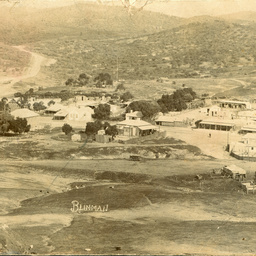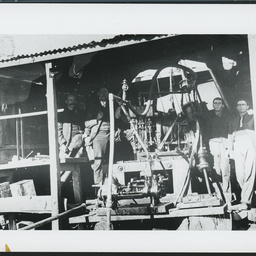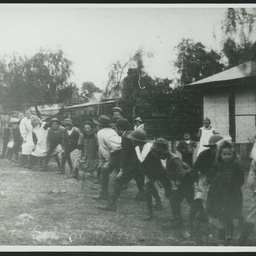Find • blinman • Results 1 to 30 of 215


North Blinman Hotel
A stagecoach has pulled up in front of C. Faulkner's North-Blinman Hotel watched by a crowd of locals who have assembled on the verandah.


North Blinman Hotel
North Blinman Hotel, located in Blinman, South Australia, with two men and a young boy standing at the entrance.


Blinman
Panoramic view of the township of Blinman in 1901. Blinman is located deep in the Flinders Ranges. Shepherd, Robert Blinman found copper ore, thus the Wheal Blinman was established. By 1862 five shafts had been sunk. Lack of water and fodder for the bullocks were a stumbling block. Water and firewood had to be transported from afar. Mining continued until 1918 when the ore ran out. The photograph, taken from the hillside shows the main street and a couple of two storey buildings amid other homes and small holdings.


Camel and Cart, Blinman
Camel and cart outside J.E. Jones' store, Blinman. Blinman is the highest surveyed town in South Australia. At the height of copper mining in the area the population rose to 2,000 people.


Donkey Team, Blinman
[General description] Donkey team resting on the outside of the Blinman mine. Mine buildings can be seen in the background.


Blinman
Bullock team hauling a wagon down the street at Blinman. This land belonged to the Adnyamathanha people who cared for it by performing regular controlled bushfires which promoted plant growth. Mining became popular after Robert Blinman discovered copper in the vicinity. The hotel and post office were opened in 1863, and shops developed from 1869. In the main street stands an Institute Building. Nearby Nuccaleena had a Miners Institute which opened in 1861 and here the miners were entertained by band music and visiting speakers


Monument, Blinman
Grave and headstone of W. D. Kekwick, Blinman cemetery. William Darton Kekwick, explorer, was born in London December 3, 1822 and died at Blinman October 16, 1872. He accompanied John McDouall Stuart as second in command on his third exploration to the centre of Australia from 1859-1863. Following this successful expedition Kekwick joined an exploration led by William Christie Gosse into Central Australia. Unfortunately he became ill and died before the expedition departed


Blinman Mine
Blinman mine. Blinman is a copper town surrounded by spectacular countryside. Copper was discovered by a shepherd, Robert Blinman, in 1859. Copper mining occurred in the area from 1862 to 1918 when the ore ran out. 10,000 tonnes of copper were removed from 200,000 tons of ore


Blinman
Panoramic view of the township of Blinman. Blinman is the highest surveyed town in South Australia.At the height of copper mining in the area the population rose to 2,000 people. A hotel and post office were established in 1863 and in 1864 a government surveyor laid out 162 allotments which became the town of Blinman. A school was established in 1868


Blinman
BLINMAN: Aboriginal people and white settlers near Blinman possibly on Christmas Day. Photograph marked "The Full Company - Ango Station 1907".


Blinman
Stagecoach outside C. Faulkner Hotel, North Blinman.


Grave of explorer William Darton Kekwick at Blinman
Graves at Blinman Cemetery, with the grave of explorer William Darton Kekwick in the foreground.


Native camp at Blinman
Photograph of a group of Indigenous men and women with dogs, identified as 'native camp. Blinman', with shelters, trees and a campfire in view.


A street in the township of Blinman, 1897-98
Photograph of a building lined street in Blinman, with a person standing beside a horse and cart in the street. Identified as 'Blinman 1897-98'.


Owner of the Wadna shop, near Blinman
Owner of the Wadna shop displaying Aboriginal items for sale, near Blinman.


Mine, Blinman
Blinman Mine October 9 1920. The ore from Beltana was at one time also smelted at Blinman: this mine was finally abandoned.


Monument, Blinman
Monument, Blinman in memory of William Darton Kekwick, second in command of Stuart's expedition, 1862. He accompanied explorer John McDougall Stuart on four journeys of exploration, which included three attempts to cross the continent from Adelaide to the Indian Ocean.


Blinman
Panoramic view of Blinman looking south showing two young girls sitting on rocks in the foreground. Blinman at this time was a collection of sparsely located cottages. The Flinders Ranges can be seen in the distance.


Camel Team, Blinman
[General description] Camel team, Blinman hauling goods in wagons.


Horses and Wagons, Blinman
Horse teams and wagons carting goods on the outskirts of Blinman. Wood had to be transported to the township


Camels, Blinman
A string of camels carrying goods on the outskirts of Blinman township. Blinman is the highest surveyed town in South Australia. At the height of copper mining in the area the population rose to 2,000 people.


Mine Winch, Blinman
Mine winch at Blinman Mine : Mr. R.B. Bradford suggests that the machinery in centre is a diamond drill with a small Worthington steam pump in foreground.


Chimney Stack, Blinman
Two people stand at the base of the old chimney stack at the Blinman Mine.


Mine Workers, Blinman
Workers from the open cut mine at Blinman on their tea break. The two men standing on the right have been identified as William Whitford Senior (second from right) and his son, William Whitford Junior (far right).


Blinman Mine
Two women stand in front of discarded boilers at the Blinman Mine.


Royal Mail Coach, Blinman
Royal Mail Coach outside Blinman Post Office.


Schoolchildren, Blinman
Starting a race in the schoolyard at Blinman School.


The Blinman Hotel
An early automobile outside the Blinman Hotel.


Goat Cart, Blinman
A goat cart on Main Street at Blinman.


Goat Cart, Blinman
A young boy tending a goat cart loaded with wood on the way to Blinman township.
